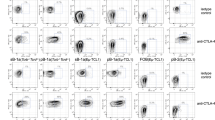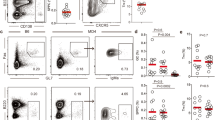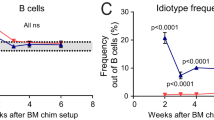Abstract
Immunological tolerance can be mediated by anergy, in which self-reactive B cells persist in the periphery yet remain unresponsive to immunogen. Whether anergy is induced after transient exposure to self antigen and is 'remembered' or requires continuous antigen receptor occupancy and transduction of signals remains unclear. We have explored this using an immunoglobulin-transgenic mouse in which B cells were hapten specific (arsonate) yet cross-reacted with a self antigen that induced anergy in vivo. Many features of anergic cells were rapidly reversed after dissociation of self antigen using hapten competition and these cells regained antigen responsiveness. Our findings indicate that continuous binding of antigen and subsequent receptor signaling are essential for the maintenance of anergy.
This is a preview of subscription content, access via your institution
Access options
Subscribe to this journal
Receive 12 print issues and online access
$209.00 per year
only $17.42 per issue
Buy this article
- Purchase on Springer Link
- Instant access to full article PDF
Prices may be subject to local taxes which are calculated during checkout








Similar content being viewed by others
References
Wardemann, H. et al. Predominant autoantibody production by early human B cell precursors. Science 301, 1374–1377 (2003).
Grandien, A., Fucs, R., Nobrega, A., Andersson, J. & Coutinho, A. Negative selection of multireactive B cell clones in normal adult mice. Eur. J. Immunol. 24, 1345–1352 (1994).
Benschop, R.J. et al. Activation and anergy in bone marrow B cells of a novel immunoglobulin transgenic mouse that is both hapten specific and autoreactive. Immunity 14, 33–43 (2001).
Glynne, R., Ghandour, G., Rayner, J., Mack, D.H. & Goodnow, C.C. B-lymphocyte quiescence, tolerance and activation as viewed by global gene expression profiling on microarrays. Immunol. Rev. 176, 216–246 (2000).
Healy, J.I. & Goodnow, C.C. Positive versus negative signaling by lymphocyte antigen receptors. Annu. Rev. Immunol. 16, 645–670 (1998).
Mason, D.Y., Jones, M. & Goodnow, C.C. Development and follicular localization of tolerant B lymphocytes in lysozyme/anti-lysozyme IgM/IgD transgenic mice. Int. Immunol. 4, 163–175 (1992).
Goodnow, C.C. et al. Altered immunoglobulin expression and functional silencing of self-reactive B lymphocytes in transgenic mice. Nature 334, 676–682 (1988).
Goodnow, C.C., Crosbie, J., Jorgensen, H., Brink, R.A. & Basten, A. Induction of self-tolerance in mature peripheral B lymphocytes. Nature 342, 385–391 (1989).
Hartley, S.B. et al. Elimination from peripheral lymphoid tissues of self-reactive B lymphocytes recognizing membrane-bound antigens. Nature 353, 765–769 (1991).
Akkaraju, S., Canaan, K. & Goodnow, C.C. Self-reactive B cells are not eliminated or inactivated by autoantigen expressed on thyroid epithelial cells. J. Exp. Med. 186, 2005–2012 (1997).
Cooke, M.P. et al. Immunoglobulin signal transduction guides the specificity of B cell-T cell interactions and is blocked in tolerant self-reactive B cells. J. Exp. Med. 179, 425–438 (1994).
Healy, J.I. et al. Different nuclear signals are activated by the B cell receptor during positive versus negative signaling. Immunity 6, 419–428 (1997).
Erickson, J.W., Posner, R.G., Goldstein, B., Holowka, D. & Baird, B. Bivalent ligand dissociation kinetics from receptor-bound immunoglobulin E: evidence for a time-dependent increase in ligand rebinding at the cell surface. Biochemistry 30, 2357–2363 (1991).
Posner, R.G., Erickson, J.W., Holowka, D., Baird, B. & Goldstein, B. Dissociation kinetics of bivalent ligand-immunoglobulin E aggregates in solution. Biochemistry 30, 2348–2356 (1991).
Sonoda, E. et al. B cell development under the condition of allelic inclusion. Immunity 6, 225–233 (1997).
Borrero, M. & Clarke, S.H. Low-affinity anti-Smith antigen B cells are regulated by anergy as opposed to developmental arrest or differentiation to B-1. J. Immunol. 168, 13–21 (2002).
Erikson, J. et al. Expression of anti-DNA immunoglobulin transgenes in non-autoimmune mice. Nature 349, 331–334 (1991).
Lenschow, D.J. et al. Differential up-regulation of the B7–1 and B7–2 costimulatory molecules after Ig receptor engagement by antigen. J. Immunol. 153, 1990–1997 (1994).
Wither, J.E., Paterson, A.D. & Vukusic, B. Genetic dissection of B cell traits in New Zealand black mice. The expanded population of B cells expressing up-regulated costimulatory molecules shows linkage to Nba2. Eur. J. Immunol. 30, 356–365 (2000).
Wither, J.E., Roy, V. & Brennan, L.A. Activated B cells express increased levels of costimulatory molecules in young autoimmune NZB and (NZB × NZW)F(1) mice. Clin. Immunol. 94, 51–63 (2000).
Pike, B.L., Boyd, A.W. & Nossal, G.J. Clonal anergy: the universally anergic B lymphocyte. Proc. Natl. Acad. Sci. USA 79, 2013–2017 (1982).
Fulcher, D.A. & Basten, A. Reduced life span of anergic self-reactive B cells in a double-transgenic model. J. Exp. Med. 179, 125–134 (1994).
Harmon, J.M., Norman, M.R., Fowlkes, B.J. & Thompson, E.B. Dexamethasone induces irreversible G1 arrest and death of a human lymphoid cell line. J. Cell. Physiol. 98, 267–278 (1979).
Thompson, J.S. et al. BAFF binds to the tumor necrosis factor receptor-like molecule B cell maturation antigen and is important for maintaining the peripheral B cell population. J. Exp. Med. 192, 129–135 (2000).
Secrist, J.P., Burns, L.A., Karnitz, L., Koretzky, G.A. & Abraham, R.T. Stimulatory effects of the protein tyrosine phosphatase inhibitor, pervanadate, on T-cell activation events. J. Biol. Chem. 268, 5886–5893 (1993).
Rathmell, J.C., Fournier, S., Weintraub, B.C., Allison, J.P. & Goodnow, C.C. Repression of B7.2 on self-reactive B cells is essential to prevent proliferation and allow Fas-mediated deletion by CD4+ T cells. J. Exp. Med. 188, 651–659 (1998).
Goodnow, C.C., Brink, R. & Adams, E. Breakdown of self-tolerance in anergic B lymphocytes. Nature 352, 532–536 (1991).
Vilen, B.J., Famiglietti, S.J., Carbone, A.M., Kay, B.K. & Cambier, J.C. B cell antigen receptor desensitization: disruption of receptor coupling to tyrosine kinase activation. J. Immunol. 159, 231–243 (1997).
Cook, M.C., Basten, A. & Fazekas de St Groth, B. Rescue of self-reactive B cells by provision of T cell help in vivo. Eur. J. Immunol. 28, 2549–2558 (1998).
Lane, P. A molecular basis for T-dependent B cell activation. Behring Inst. Mitt. 96, 7–12 (1995).
Ding, L., Green, J.M., Thompson, C.B. & Shevach, E.M. B7/CD28-dependent and -independent induction of CD40 ligand expression. J. Immunol. 155, 5124–5132 (1995).
Bretscher, P. & Cohn, M. A theory of self-nonself discrimination. Science 169, 1042–1049 (1970).
Acknowledgements
We thank K. Aviszus and L. Wysocki for Ars/A1 mice (for breeding), for ArsTyr and for input, and R. Pelanda for B1-8 mice (for breeding). Supported by the National Institutes of Health (R01-AI020519) and Nelson Family Fellowship for Pediatric Immunology from the National Jewish Medical and Research Center (S.B.G.).
Author information
Authors and Affiliations
Corresponding author
Ethics declarations
Competing interests
The authors declare no competing financial interests.
Rights and permissions
About this article
Cite this article
Gauld, S., Benschop, R., Merrell, K. et al. Maintenance of B cell anergy requires constant antigen receptor occupancy and signaling. Nat Immunol 6, 1160–1167 (2005). https://doi.org/10.1038/ni1256
Received:
Accepted:
Published:
Issue Date:
DOI: https://doi.org/10.1038/ni1256
This article is cited by
-
Nfkbie-deficiency leads to increased susceptibility to develop B-cell lymphoproliferative disorders in aged mice
Blood Cancer Journal (2020)
-
Re-educating immunity in respiratory allergies: the potential for hematopoietic stem cell-mediated gene therapy
Journal of Molecular Medicine (2018)
-
Silencing of high-affinity insulin-reactive B lymphocytes by anergy and impact of the NOD genetic background in mice
Diabetologia (2018)
-
B cells in type 1 diabetes mellitus and diabetic kidney disease
Nature Reviews Nephrology (2017)
-
Intracellular B Lymphocyte Signalling and the Regulation of Humoral Immunity and Autoimmunity
Clinical Reviews in Allergy & Immunology (2017)



